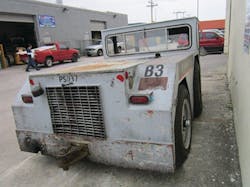Most Brazilians think the world believes their national language is Spanish (it’s Portuguese) and that their capital is Buenos Aires (that’s the capital of Argentina).
But an expected 600,000 visitors are expected to descend upon the country to attend the World Cup next year and even more travelers will be flying to Rio de Janeiro in 2016 for the Summer Olympics.
And the linguistic- and geographically-challenged outsiders may learn a third fact about Brazil: The airports are in terrible shape.
Whether it’s red tape hold down public funds or private dollars chickening out, Brazil needs to get 12 stadiums in 12 cities up and running for the first soccer game on June 12. Considering the country occupies 3.2 million square miles and that at least two of the stadiums are almost as far apart as New York City is from Los Angeles, getting the nation’s airports in shape is just as important to successfully running this and the other major sporting events.
While the government has earmarked some $3 billion to fund airport improvements, getting these facilities in shape remains a tall order since most are still mired in government ownership.
That situation is beginning to change as sky-high prices for airports raise the prospects for more sell-offs by the government.
PRIVATIZATION
Take the privatization of Sao Paulo-Guarulhos International Airport as an example. It’s Brazil’s busiest airport catering to more than 32 million passengers in 2012 – double the number of passengers from 2006.
The winning bid to take over managing the airport last year was $9.4 billion almost $2 billion more than second-highest bid. Despite the sky-high bid, the deal for GRU remains a public-private partnership with Infraero, Brazil’s state-owned operator of 66 airports, retaining a 49 percent stake (although no management responsibilities).
GRU is the airport most travelers will be likely flying into for World Cup soccer. A quick look on the Internet suggests this is one nightmare airport for passengers and planes alike. Air carriers typically are forced into a holding pattern because there’s no where land.
However, the new management is building a new terminal and increasing slots for aircraft, and intends to spend $3 billion in improvement over the next three years.
Spurred on by this private financing, private ground handlers are certainly gearing up to meet the growing demands of GRU and other airports in Brazil.
While we were unable to dig up current data on the size of the country’s airport airside services market, we did find an old report from international consultant Frost & Sullivan that expected the market to reach $385 million by 2012.
Swissport International, for one, signed a three-year contract extension earlier this year with Brazilian airline GOL, for aircraft services and ramp handling at six airports in Brazil.
The contract covers ramp services at Eduardo Gomes International airport in Manaus, Rio de Janeiro-Galeao airport, São Paulo’s Guarulhos International and Congonhas International airports, Brasilia’s Presidente Juscelino Kubitschek airport, and Salgado Filho airport in Porto Alegre.
“We are very pleased to extend our partnership with GOL for a further three years, and we look forward to working together to develop our services, applying best practice from across the global Swissport group to drive efficiency gains and performance improvements, said Francisco Gonçalves, CEO for Swissport International in Brazil in prepared remarks. “Swissport is committed to continuing to build our services in Brazil as its aviation market expands, sharing the benefits of Swissport’s international experience.”
Swissport appears to be largest ground handler in Brazil, entering the market in 1997 and breaking a stranglehold on the country’s ground handling market held by Brazil’s Servicos Auxiliares de Transporte Aereo (SATA), which was established in the 1950s.
AEROSERVICIOS
As we researched this story, we had the good luck to run into Gabriel Serrano and Guillermo Gonzalez, both of Aeroservicios Ground Support Equipment, Miami, FL, at last month’s AviationPros LIVE in Las Vegas, NV, who both knew a thing or two about the GSE market in throughout Latin America.
“The South American GSE market is really made up of two markets,” Serrano says. “One market is for Brazil and the other market is for all others. It really is two different worlds.”
Established in 1996, Aeroservicios has quietly grown to be one of the biggest suppliers of refurbished GSE worldwide. More than 70 technicians and mechanics work out of its more than 110,000 square foot Miami warehouse. The facility includes a sandblasting booth, paint booth, assembly line, engine and transmission shop, spare parts and stock area.
The company has more than 1,300 pieces of GSE in stock from towbars to cargo loaders. As part of the business, its GSE-Rentals division also offers rental programs for all GSE needs.
“We work with some ground handlers in Brazil, and all of them are worried on how to handle such a big volume in flights in such a short time,” Serrano adds regarding the run-up to the World Cup and Olympics. “This is the big question.”
About a third of Aeroservicios’ business is sold in the United States, with rest of its sales spread throughout Mexico, the Caribbean, and Central and South America. However, less than 2 percent of that business is in Brazil.
Serrano points to import restrictions and high duty fees as the culprit for low sales, but then adds the real deal killer – used GSE is not permitted as a permanent import.
“There are some special conditions for foreign airlines,” Serrano explains, “that allow them to import new and used equipment for their own use.”
Serrano threw out one GSE manufacturer in Brazilian we were unable to find out much about. He didn’t share a high opinion of it. “The prices are very high and the technology is very old,” he said. “But this is the only option many in the country may have.”
Despite tariffs, Serrano said Hobart, Tug Technologies and TLD had good presence in the Brazilian GSE market.





